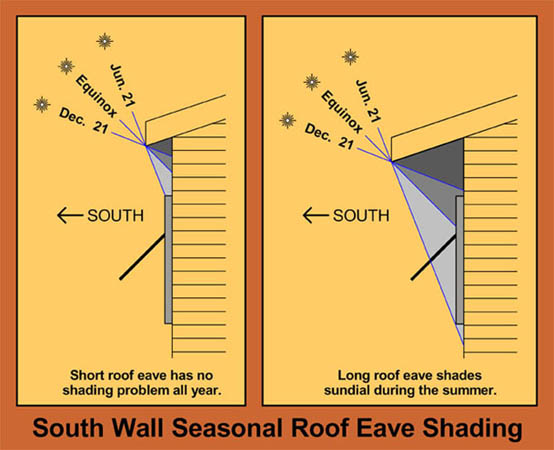

A good location for a glass sundial window is that part a wall or roof that receives full or filtered sunshine for most of the daylight hours and for most of the year. This maximizes the amount of time that the sundial will function. You can use any wall or roof that receives sunlight, but the best locations in terms of performance are vertical walls that face due south in the Northern Hemisphere or due north in the Southern Hemisphere, and horizontal flat roofs (like a skylight). These sundials function for most of the day and for most of the year. On the other hand, you can have a sundial window on an east, west or even a north wall, but these sundials will only tell time for part of the day or part of the year. East wall windows will only function in the morning and west wall sundials will only function in the afternoon. North wall windows function in the summer only. In the tropics, vertical sundial windows will only tell time for about six months of the year if they are near the equator because the sun is behind the building and doesn't shine on the window.
In theory, one can design a sundial for any surface that receives sunlight, even angled, tilted and curved surfaces. But these odd sundials' calculation, construction and installation, particularly the tricky placement of the gnomon (the shadow caster), are more difficult. South wall and flat ceiling sundials are definitely the easiest to design, construct and install. If you want a window for a wall that doesn't face south or that is not vertical, to avoid errors, I suggest that you work closely with a sundial designer in your local area who would be willing to personally visit the building, take wall measurements and help you with the window and gnomon installation.
 |
To maximize the number of hours that the sundial will function, locate it as high above the ground as possible. This minimizes shading from nearby plants and buildings and also makes it more visible and useful inside the room. It also protects the gnomon from damage by curious hands by placing it high and out of reach. But be careful not to place it so high up that a roof eave overhang shades it at noon or in the summer when the sun is high. Roof eave overhang is the enemy of wall and window sundials! Installing a protruding bay window for the sundial may solve in a beautiful way the problem of roof eave shading. (See the exterior photos of The Marlborough Dial: Dial 19 in the Image Archive, 17th Century). There may also be shading problems from the building's wall if it is very thick and the window is on the interior side. The sundial designer should calculate if roof eave overhang or wall thickness will be a problem by using the eave and wall dimensions. |
|